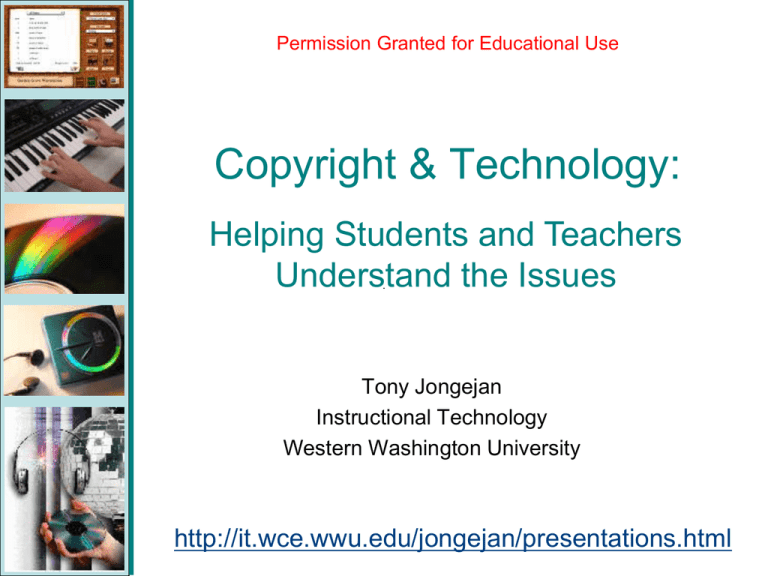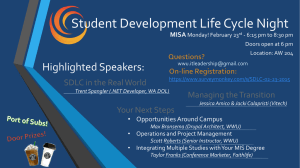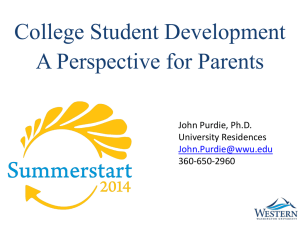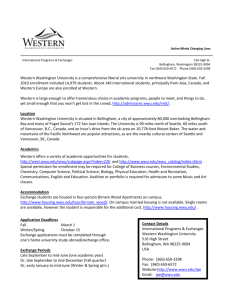Kids, Copyright & Technology
advertisement

Permission Granted for Educational Use Copyright & Technology: Helping Students and Teachers Understand the Issues Tony Jongejan Instructional Technology Western Washington University http://it.wce.wwu.edu/jongejan/presentations.html Content • Examine copyright law – common media (e.g., music, video, and software) – an educator’s perspective • Explore resources for students – activities that you can use/share – for discussing copyright • The Future and Copyright http://it.wce.wwu.edu/jongejan/presentations.html Scenario #1 While you are at NECC you set your VCR to record Dancing with the Stars so that you can watch the latest episode when you get home. (L)egal, (I)llegal or is (M)ore information required? http://it.wce.wwu.edu/jongejan/presentations.html Presentation Outline • Copyright and students • Brief history of copyright • An interactive activity based on copyright scenarios • A look at web-based copyright resources • Activities for use with students • What has technology done to copyright and what might the future bring • Question: Is current copyright law obsolete? http://it.wce.wwu.edu/jongejan/presentations.html Scenario #2 Students in Mr. Brockington's 5th grade class are making 'State Reports.' He has them download the required map from the Internet. (L)egal, (I)llegal or is (M)ore information required? http://it.wce.wwu.edu/jongejan/presentations.html Disclaimers • Best attempt to explain copyright law as we understand it.. Lawyers … Lawyers … Lawyers … • Other people; other sites; other answers. • Information/strategies will help you to familiarize your students with the copyright issues. http://it.wce.wwu.edu/jongejan/presentations.html Scenerio #3 You record an excellent movie on the History of Copyright on your VCR and show it to your classes the next week. (L)egal, (I)llegal or is (M)ore information required? http://it.wce.wwu.edu/jongejan/presentations.html What is Copyright? Copyright refers to a set of laws and/or rules set up to protect the intellectual property of others. The easiest way to think of it is this: Imagine you are an artist of some sort, and a complete stranger took your creation (a song, painting, story, etc) and used it without your permission to serve their own purposes. You worked very hard on that creation, do you really want another person using it? Copyright protects your ownership of anything you create so others can’t use it for any purpose without your permission. http://it.wce.wwu.edu/jongejan/presentations.html What is covered? Copyright covers any intellectual property (e.g., Movies, Music, Art, Software) Without going into the details, everyone knows that you shouldn’t copy CDs for a friend, right? This is illegal due to copyright laws. Copyright laws exist in most countries, but they are different depending on where you are, so if you want more information, do as much research as possible. http://it.wce.wwu.edu/jongejan/presentations.html Scenerio #4 You have a CD ROM music collection and decide to burn your favorites onto a CD for listening in your car. (L)egal, (I)llegal or is (M)ore information required? http://it.wce.wwu.edu/jongejan/presentations.html Balance (tug) between instructional use and copyright! Holly Holy by Neil Diamond I Am Australian by the Seekers http://it.wce.wwu.edu/jongejan/presentations.html FilmFest Balance (tug) between instructional use and copyright! “ All films must meet copyright guidelines outlined for YouTube. If the film would be de-posted at YouTube it will not be eligible for this festival. Guidelines can be found at http://www.youtube.com/t/howto_copyright “ http://it.wce.wwu.edu/jongejan/presentations.html Balance (tug) between instructional use and copyright! Fiona Hawthorne http://www.fionahawthorne.com/CopyrightFreeImages/CopyrighFree.html http://it.wce.wwu.edu/jongejan/presentations.html Brief History of Copyright --Or what is current copyright law based Source: Access Denied: The Limits of Fair Use By Elliot Zaret http://it.wce.wwu.edu/jongejan/presentations.html History of Copyright 1600 1700 1800 1900 2000 Copyright Law of 1976 Queen Anne Statute of Anne (1709) first US copyright law (1790/1834) U.S. Constitution Copyright Case (1984) concept of “fair use” (1841) Digital Millennium Copyright Act (1998) RIAA/mp3 (1999) Napster (1999) Teach Act (2003) http://it.wce.wwu.edu/jongejan/presentations.html History of Copyright • Mid-16th century Queen Anne of England issued the Star Chamber decree giving sole control of all printed works to a single company. The idea, cemented through a series of 17th-century acts, was that by controlling the licensing and distribution, the crown could control the information itself. In short, the acts were a tool for censorship. • 1709: British parliament passed Statute of Anne granting ownership to the author for a limited duration, after which the work would become public. The temporary monopoly was intended to give economic incentive to authors and to stimulate new writing. Because of the restricted duration, however, authors could avoid state censorship. • The statute’s economic principles became the foundation for modern copyright law. http://it.wce.wwu.edu/jongejan/presentations.html How Long Does Copyright Last The time limitations were crucial to the founders • Created on or after January 1, 1978, the duration of copyright, for most works, is the life of the author plus 70 years. (Sonny Bono Copyright Term Extension Act) • Created Prior to January 1, 1978 28 years + a 47-year renewal and for practical purposes should be considered to be 75 years. http://it.wce.wwu.edu/jongejan/presentations.html History of Copyright • U.S. Constitution (Article 1, section 8) gave Congress the right “to promote the Progress of Science and useful Arts, by securing for limited Times to Authors and Inventors the exclusive Right to their respective Writings and Discoveries.” • 1790: Congress passed first copyright law protecting books, maps, and charts to 28 years. In 1831 amended the law to include musical works and extended the term to 42 years. http://it.wce.wwu.edu/jongejan/presentations.html U.S. Constitution • Balance between incentive to create and the control of information • “…to promote the Progress of Science and useful Arts, by securing limited Times to Authors and Inventors the exclusive Right to their respective Writings and Discoveries.” Article 1, section 8 U.S. Constitution http://it.wce.wwu.edu/jongejan/presentations.html History of Copyright • 1841: U.S. Supreme Court first upheld the concept of “fair use” addressing the free speech rights of the First Amendment • 1976: fair use added to the copyright statute – A major rewrite of the act (reaction to Sony Betamax) – Not definitive on the specifics of fair use – Best judgment vs court cases – Did not anticipate changes in next 25 years http://it.wce.wwu.edu/jongejan/presentations.html Fair Use • Copyright Act of 1976 • Test of brevity of the material, the spontaneity, and the cumulative effect of the creation • Factors to consider 1. Purpose and character of the use 2. Nature of the material 3. Amount of the portion used 4. Effect on the potential market http://www.wwu.edu/publishingservices/copyright/copyrightservices.htm http://it.wce.wwu.edu/jongejan/presentations.html History of Copyright • 1976-1984: Universal Studios & Disney sued Sony for copyright infringement with Betamax – Supreme Court in 5-4 decision for Sony (introduced “time shifting”) Digital copying vs analog copying • 1999: Recording Industry Association of America (RIAA) vs Diamond Multi-Media’s Rio (first MP3 player) – Ninth Court of Appeals agreed with Diamond MultiMedia – Introduced the concept of “space shifting” – Not for computers http://it.wce.wwu.edu/jongejan/presentations.html History of Copyright • June 1999: Napster and “peer to peer” (P2P) copying – December: RIAA sued for 100 million – July: company shut down • Adding copy protection vs fair use • 1998: Congress enacted the Digital Millennium Copyright Act – Illegal to circumvent copy protection schemes • DVDs and copy protection -- an agreed to standard and “the beat goes on” • The TEACH Act for distance delivery (2002) http://it.wce.wwu.edu/jongejan/presentations.html A set of exceptions to copyright laws Enacted in the Copyright Act of 1976. Protects journalists, educators and satirists from lawsuits Wikipedia and the terms ‘Fair Use’ http://en.wikipedia.org/wiki/Fair_use http://it.wce.wwu.edu/jongejan/presentations.html Factors covered by Fair Use 1. Purpose and character of the use Why are you using this material? 2. Nature of the material In what form are you using the material? 3. Amount of the portion used How much of the original work are you using? 4. Effect on the potential market Does your use hurt the original owner financially? http://it.wce.wwu.edu/jongejan/presentations.html Fair Use for Educators The Fair Use law is purposely vague, so it can be decided by the courts on a case-by-case basis. For this reason, interpretation, and therefore responsibility is left to the individual/institution using the copyrighted material. http://it.wce.wwu.edu/jongejan/presentations.html Fair Use for Educators Here are 3 tests to help you along the way: 1. Brevity (Amount) Use only as much of the material as you need. Use the material only once 2. Spontaneity If you don’t have the time to request permission from the owner after the original creation date, see #1 3. Cumulative effect Use only what supports your instructional goal. http://it.wce.wwu.edu/jongejan/presentations.html Fair Use Links on the Web Copyright Law of the United States of America and Related Laws Contained in Title 17 of the United States Code – Fair Use •http://www.copyright.gov/fls/fl102.html •http://chillingeffects.org/fairuse/ •http://www.copyrightwebsite.com/Info/Law/FairUse.aspx •http://fairuse.stanford.edu/Copyright_and_Fair_Use_Overview/chapter9/ http://it.wce.wwu.edu/jongejan/presentations.html Copyright Guidelines for Administrators •Hall Davidson •Part One (pdf): –Copyright Primer for Administrators –Five Steps to Avoiding Copyright Problems –Quick Quiz •Part Two (pdf): –Chart: Copyright Guidelines for Administrators •http://www.techlearning.com/copyrightguide/index.php http://it.wce.wwu.edu/jongejan/presentations.html Comments from Students What will they do? Will I get arrested? They make so much money -- they will never miss it. Napster: I am enhancing the value! I bought it! Why can’t I do what I want? http://it.wce.wwu.edu/jongejan/presentations.html It Can Happen To You! 1. Downloaders face the music as record industry sues Paying $750 for Duran Duran's "Girls on Film"? That's what some Washingtonians accused of illegally downloading music have been forced to fork over for a stolen track. Seattle PI 2. 15 WWU students face possibility of lawsuits Fifteen Western Washington University students will face lawsuits for illegally downloading music if they don’t accept settlement offers from the RIAA Bellingham Herald 3. Music Theft on 19 Campuses Targeted in Wave of RIAA Pre-Lawsuit Letters Recording Industry Association of America (RIAA) http://it.wce.wwu.edu/jongejan/presentations.html Consider • Students do not understand ….. – copyright law (or value it) and….. – its impact on the creative work of an individual or…… – the individual’s ability to continue the creative process. • Technology is making it easier and easier to duplicate copyrighted work • Technology is changing how copyrighted work is paid for and distributed. http://it.wce.wwu.edu/jongejan/presentations.html Alternate Approaches • Create a list of websites with ‘Free’ resources (e.g., sample) • Web 2.0 Image Websites (e.g., Flickr) • Purchase Royalty Free Content for Classroom Use (Samples below) – The SMART Learning Marketplace – FTC Publishing SoundPak http://it.wce.wwu.edu/jongejan/presentations.html Copyright Basics for Kids Copyright by Cyberbee http://www.cyberbee.com/copyrt.html http://it.wce.wwu.edu/jongejan/presentations.html Strategies School Setting – Do Learn – Do Teach – Do Model – Do Set Requirements/Rules – Don’t lecture Home Setting My experience is that we need to lay out the issues and laws and then let students decide for themselves the impact that it will have on them and how they behave. http://it.wce.wwu.edu/jongejan/presentations.html An interactive activity based on copyright scenarios http://it.wce.wwu.edu/jongejan/presentations.html An Interactive Activity Copyright Lesson: Basic Instructional Technology Skills Created by Jason Myers, WWU/IT graduate student Jeopordy http://it.wce.wwu.edu/344/copyright/default.html http://it.wce.wwu.edu/jongejan/presentations.html Other Interactive Activities • Ethics in Computer Use: Copyright Scenarios • The Educator's Guide to Copyright and Fair Use Quiz by Hall Davidson • Copyright and Ethical Issues: Avoiding the http://www.biomedcentral.com/openaccess/inquiry/myths/?myth=copyright Copyright Police by Harvey Barnett http://it.wce.wwu.edu/jongejan/presentations.html Web-based Copyright Resources http://it.wce.wwu.edu/jongejan/presentations.html http://www.copyrightkids.org/ Copyright Kids http://it.wce.wwu.edu/jongejan/presentations.html Web Resources http://www.benedict.com/ WebQuests •The Copyright WebQuest by Miguel Guhlin •Music and Copyright WebQuest •Copyright WebQuest Multimedia Copyright Guidelines for Students Copyright Guidelines for Student Multimedia Projects http://www.hazelwood.k12.mo.us/~jdarnell/webq http://it.wce.wwu.edu/jongejan/presentations.html Other Resources • Captain Copyright (Canadian) • PBS TeacherSource: Copyright Educational Multimedia Guidelines. Proposal for Fair Use Guidelines for Educational Multimedia • Recording Industry Association of America (RIAA) http://it.wce.wwu.edu/jongejan/presentations.html Teacher Resources Kathy Schrock's Guide for Educators Ready Reference & Copyright ISTE On-Line: Copyright Articles Learning and Leading with Technology http://it.wce.wwu.edu/jongejan/presentations.html Copyright Guidelines for Administrators • Hall Davidson • Part One (pdf): – Copyright Primer for Administrators – Five Steps to Avoiding Copyright Problems – Quick Quiz • Part Two (pdf): – Chart: Copyright Guidelines for Administrators • http://www.techlearning.com/copyrightguide/index.php http://it.wce.wwu.edu/jongejan/presentations.html Five Steps to Avoiding Copyright Problems 1. Create and implement a technology policy that includes a code of ethics and set of procedures. 2. Review the entire policy with your educational community: students, teachers, and parents. 3. Appoint a technology manager to conduct audits and maintain a log of licenses and registration materials. 4. Teach ethical and legal behavior for technology use. 5. Thank employees and students for supporting these steps. Hall Davidson http://it.wce.wwu.edu/jongejan/presentations.html Other Resources • The UT System Crash Course in Copyright – Online presentations: Talks tailored to the audience's copyright concerns for faculty, students, staff, librarians, artists, administrators. http://www.utsystem.edu/ogc/intellectualproperty/cprtindx.htm • Copyright in the Electronic Environment (Students) – Students have rights of fair use under Copyright Law. Section 107 of the Copyright Law includes ... Students are Both Users and Creators of Copyright Works . http://www.utsystem.edu/ogc/intellectualproperty/student.htm • Right to Copy? By Stephanie Gold Article from TechLearning; January 15, 2006 online http://it.wce.wwu.edu/jongejan/presentations.html Other Resources • IvyRun – PowerPoint for training sessions for teachers http://www.ivyrun.com/education/resources/copyright.htm • Creative Commons – An alternative look at approaches to creative work. http://creativecommons.org/ http://it.wce.wwu.edu/jongejan/presentations.html What has technology done to copyright and what might the future bring? http://it.wce.wwu.edu/jongejan/presentations.html 10 Years Ago Late Late Show with Craig Ferguson Web 2.0 Text messaging Picture with cell phone Blackberry Flash Drive Cell phone with … iPhone PDA (Palm Pilot) iPod nano (mp3) http://it.wce.wwu.edu/jongejan/presentations.html Distribution • Journals: On the Web or pdf • Music: CD to Downloading (e.g., iTunes) • Video: DVD to Downloading (e.g., iTunes) • Software: CD to Downloading http://it.wce.wwu.edu/jongejan/presentations.html Consider the question: Is current copyright law obsolete? http://it.wce.wwu.edu/jongejan/presentations.html Final Thoughts • My experience is that we need to lay out the issues and laws and then let students decide for themselves the impact that it will have on them and how they behave. • They are shepherds of future creative work and would benefit from considering those issues. • It is my hope that you leave this session with some tools to begin discussing these issues with your students. http://it.wce.wwu.edu/jongejan/presentations.html Contact Information • Email: tony.jongejan@wwu.edu • Website: http://it.wce.wwu.edu/jongejan/presentations.html • Snail-Mail: Tony Jongejan 204 Miller Hall; MS 9087 Western Washington University Bellingham, WA 98225-9087 http://it.wce.wwu.edu/jongejan/presentations.html Websites • Copyright Lesson: Basic Instructional Technology Skills Created by Jason Myers • Access Denied: The Limits of Fair Use By Elliot Zaret • WWU Publishing Services • Right to Copy? By Stephanie Gold Article from TechLearning; January 15, 2006 online http://it.wce.wwu.edu/jongejan/presentations.html Web Sites • http://www.techlearning.com/story/showArticl e.jhtml?articleID=175802920 • http://www.dcbar.org/for_lawyers/washington _lawyer/february_2003/access.cfm http://it.wce.wwu.edu/jongejan/presentations.html The End http://it.wce.wwu.edu/jongejan/presentations.html





